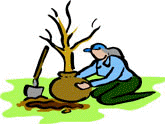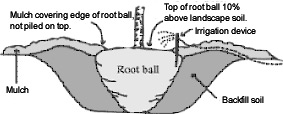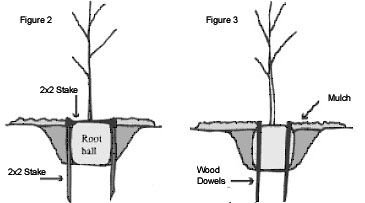 |
|
||||||||||||||
Get Our Free Newsletter
|
 Before you begin spring landscaping, here are some tips on planting trees. Before you begin spring landscaping, here are some tips on planting trees.1. Select the right tree for the site. To avoid serious problems, choose trees that are adapted to your location. Consider whether the tree produces nuisance fruit or if there are disease-resistant varieties available. For example, there are a number of crabapple varieties that are resistant to apple scab and rust diseases. Also consider the mature size of a tree to be sure you have enough room. Ask a local nurseryman for suggestions. 2. Keep the tree well watered and in a shady location until planting. When moving the tree, lift it by the root ball or pot and not by the trunk. 3. Before planting, remove all wires, labels, cords or anything else tied to the plant. If left on, they may eventually girdle the branch to which they are attached. 4. Dig a proper hole. Make the hole deep enough so that the tree sits slightly above nursery level. Plant the tree on solid ground, not fill dirt. In other words, don't dig the hole too deep and then add soil back to the hole before placing the tree. The root flare (point where trunk and roots meet) should be visible. If it isn't, remove enough soil or media so that it is. The width of the planting hole is very important. It should be three times the width of the root ball. Loosening the soil outside the hole so it is five times the diameter of the root ball will allow the tree to spread its roots faster.
5. Remove all containers from the root ball. Cut away plastic and peat pots; roll burlap and wire baskets back into the hole, cutting as much of the excess cut away as possible. If you can remove the wire basket without disturbing the root ball, do it. If roots have been circling around in the container, cut them and spread them out so they do not continue growing this way inside the hole and become girdling roots later in the life of the tree. 6. Backfill the hole with the same soil that was removed. Amendments such as peat moss likely do more harm than good. Make sure the soil that goes back is loosened - no clods or clumps. Add water as you fill to insure good root to soil contact and prevent air pockets. There is no need to fertilize at planting. 7. Don't cut back the branches of a tree after planting except those that are rubbing or damaged. The leaf buds release a hormone that encourages root growth. If the tree is cut back, the reduced number of leaf buds results in less hormone released and therefore fewer roots being formed. 8. Water the tree thoroughly and then once a week for the first season if there is insufficient rainfall. 9. Mulch around the tree. THIS IS IMPORTANT! Mulch should be 2 to 4 inches deep and cover an area two to three times the diameter of the root ball. Mulching reduces competition from other plants, conserves moisture and keeps soil temperature closer to what the plants' roots prefer. 10. Stake only when necessary. Trees will establish more quickly and grow faster if they are not staked. However, larger trees or those in windy locations may need to be staked the first year. Movement is necessary for the trunk to become strong. Staking should be designed to limit movement of the root ball rather than immobilize the trunk.
In Figure 2 above, one horizontal two-by-two is screwed or nailed to two vertical two-by-twos that have been placed against the side of the root ball and driven through the planting hole into the native undisturbed soil. A second set is used on the other side if needed for larger trees. In Figure 3 above, two or three wood dowels are driven through the edge of the root ball. These do not have to be removed because they simply rot in place. There is no danger of this system girdling the trunk since nothing is attached to the trunk. Both of these inexpensive alternate systems eliminate the requirement to return to the tree to remove the staking system because they simply decay in a few years. Source: Kansas State University Research & Extension (Line drawings and explanation, courtesy of Ed Gilman, Ph.D., Professor of Environmental Horticulture, University of Florida) |
||||||||||||||
|
|
|||||||||||||||
|
© 1999 - 2010 Savvygardener.com, Inc. All rights reserved. If you wish to copy, transmit, or otherwise duplicate any of the material from our website please ask us first. Thank you. |
|||||||||||||||

